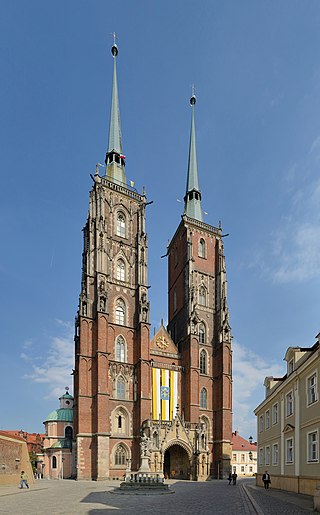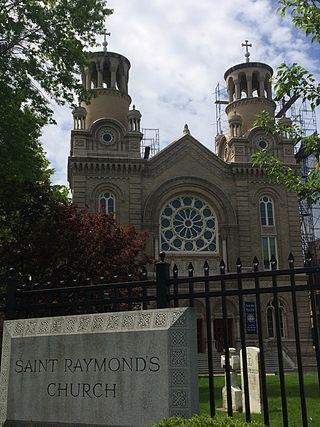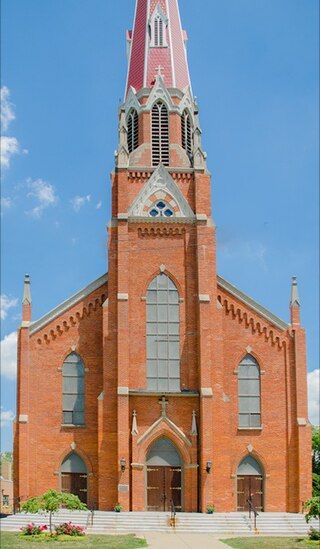
Halifax Minster is the minster church of Halifax, Calderdale, West Yorkshire, England. The church is dedicated to St John the Baptist. The parish church of the town, it was granted minster status in 2009. Halifax Minster is one of three churches in the county of West Yorkshire to be given this honorific title; the other two are Dewsbury Minster and Leeds Minster.

St. Michael's Cathedral Basilica is the cathedral church of the Roman Catholic Archdiocese of Toronto, Canada, and one of the oldest churches in Toronto. It is located at 65 Bond Street in Toronto's Garden District. St. Michael's was designed by William Thomas, designer of eight other churches in the city, and was primarily financed by Irish immigrants who resided in the area. The cathedral has a capacity of 1600. John Cochrane and Brothers undertook the work on the stone and stucco ornamentation of the interior.

St Francis Xavier's Church is a Roman Catholic church in Salisbury Street, Everton, Liverpool, Merseyside, England. The church is recorded in the National Heritage List for England as a designated Grade II* listed building. It is an active parish church in the Archdiocese of Liverpool and the Pastoral Area of Liverpool North.

Eva Sydney Hone RHA, usually known as Evie, was an Irish painter and stained glass artist. She is considered to be an early pioneer of cubism, although her best known works are stained glass. Her most notable pieces are the East Window in the Chapel at Eton College, which depicts the Crucifixion, and My Four Green Fields, which is now in the Government Buildings in Dublin.

The Cathedral of St. John the Baptist in Wrocław is the seat of the Roman Catholic Archdiocese of Wrocław and a landmark of the city of Wrocław in Poland. The cathedral, located in the Ostrów Tumski district, is a Gothic church with Neo-Gothic additions. The current standing cathedral is the fourth church to have been built on the site.

St George's Cathedral is the Anglican cathedral in Cape Town, South Africa, and the seat of the Archbishop of Cape Town. St. George's Cathedral is both the metropolitical church of the Anglican Church of Southern Africa and a congregation in the Diocese of Cape Town.

Church of the Assumption, Booterstown is a Roman Catholic church located in Booterstown, County Dublin, Ireland. The church represents the Parish of the Assumption Booterstown, which was established in 1616. The present church opened in 1813 and was built as a replacement for the old chapel that existed at the site. The construction was paid for by Richard FitzWilliam, 7th Viscount FitzWilliam who provided it for his Catholic tenants.

St. Raymond's Church is a parish church under the authority of the Roman Catholic Archdiocese of New York, located at Castle Hill Avenue at Tremont Avenue, The Bronx, New York City. The parish was established in 1842. It was dedicated on the feast of St. Raymond Nonnatus, on August 31, 1845, thus getting its name. There is a stained glass window, on the right side if you are looking at the sanctuary, of St. Raymond Nonnatus and the men who took him hostage.
Catherine Amelia "Kitty" O'Brien was an Irish stained glass artist, and a member and director of An Túr Gloine.
Patrick Pollen was a British stained-glass artist who spent most of his life working in Ireland.

St Thomas of Canterbury Church is a Roman Catholic Parish church in Canterbury, Kent, England. It was built from 1874 to 1875 in the Gothic Revival style. It is situated on the corner of Burgate and Canterbury Lane, west of Lower Bridge Street, opposite the grounds of Canterbury Cathedral in the centre of the city. It is the only Roman Catholic church in Canterbury, built on the site of a medieval church ; the old St Mary Magdalen’s Tower was retained. The church contains relics of Thomas Becket.

Saint Michael the Archangel Church is located on the west side of the city of Monroe, Michigan, along the River Raisin and is a part of the Archdiocese of Detroit. Its congregants include over 1,000 registered families. It was founded in 1852. Its current pastor is Rev. Kishore Battu, who has been serving the St. Michael community since August 1, 2020.

Michael Healy was an Irish stained glass artist, one of a small number which included Wilhelmina Geddes, Evie Hone, and Harry Clarke, who achieved international recognition for their work in this medium in the first half of the 20th century. He also achieved some distinction as an illustrator and cartoonist early on in his artistic career, and as an ongoing recorder of Dublin street characters going about their daily business. Healy also occasionally painted in oil, both portraits and landscapes, exhibiting a small number of the latter during his lifetime.
Hubert Vincent McGoldrick was a Dublin-born stained glass artist, one of a small number of Irish artists which included Michael Healy, Wilhelmina Geddes, Evie Hone, and Harry Clarke, who worked in this medium and achieved international recognition for their work in the first half of the 20th century. His career at An Túr Gloine spanned from 1920 until 1943; thereafter he produced very few works in the medium. Along with Ethel Rhind and Catherine O'Brien he was one of the artists at the studio who worked in opus-sectile mosaic, a side-line of the studio. Hubert McGoldrick was also an occasional illustrator and his most recognised illustration is the Magnificat Anima Mea Dominum created for the Legion of Mary.

St. Joseph's Church is a modern Catholic church opened in 2004 located in the central city suburb of Mt Victoria, Wellington, New Zealand, on the eastern side of the Basin Reserve.

Saint John the Baptist Catholic Church is a parish of the Roman Catholic Church in Silver Spring, Maryland, United States. It was established by the Archdiocese of Washington in 1960, and is dedicated to John the Baptist.
Helen Moloney was an Irish stained glass artist, known for her work with architect Liam McCormick in the churches he designed throughout the 1960s and 1970s.

St Anne's Church is a parish church in the village of Hessenford in Cornwall. It is dedicated to St Anne, the mother of the Virgin Mary. The church is in the Archdeaconry of Bodmin, in the Diocese of Truro. The church is largely the work of J P St Aubyn, and is Grade II listed.

St. Michan's Catholic Church is a Catholic Church located on the Northside of Dublin, Ireland. It is the parish church for the Halston Street Parish in the Archdiocese of Dublin.


















